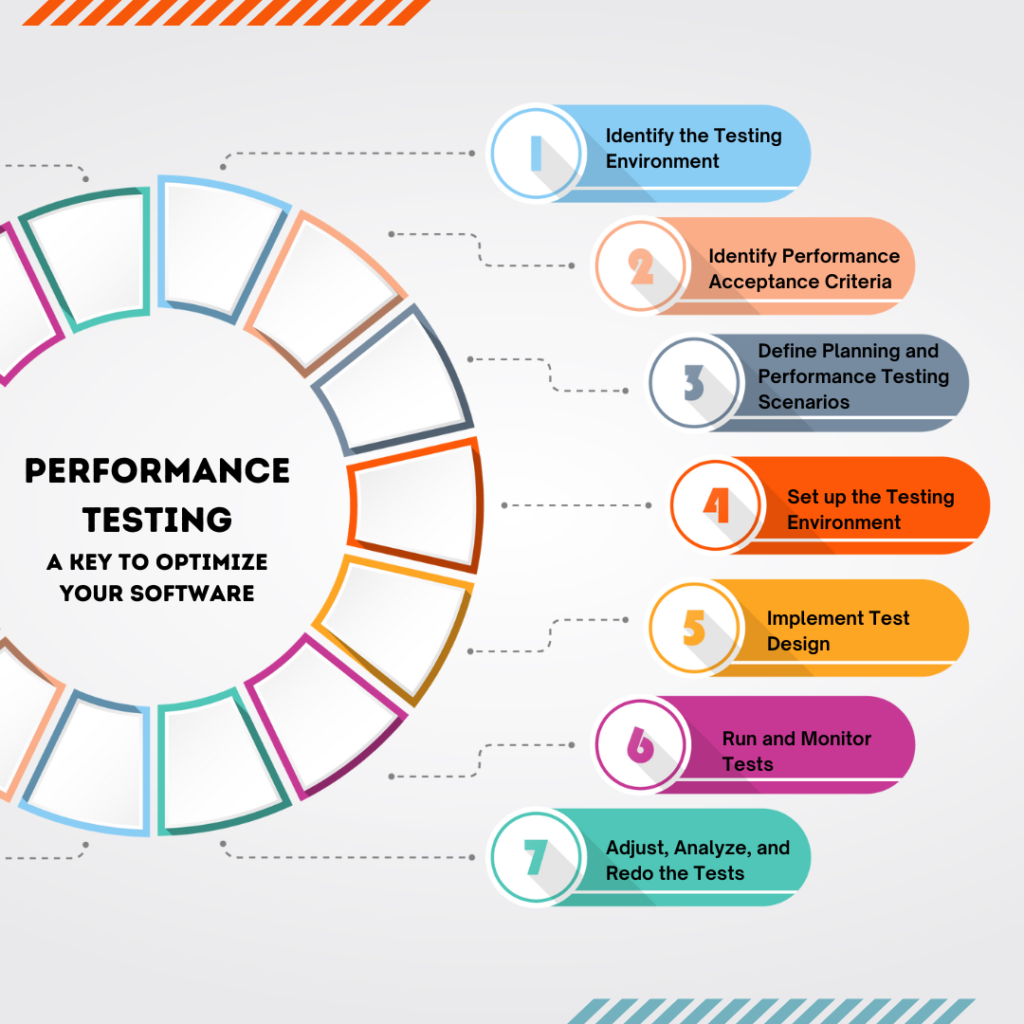- Services

Software Development Services.
Accelerate your tech projects with outsourced development. Flexible engagement models, tailored to you.
Engagement models
You can hire our software developers in different ways
Staff Augmentation
Our software developers in your team.
Dedicated Teams
Our software teams in your organization.
Software Outsourcing
Our PM and software teams building for you.
- Expertise
Expertise
Leverage our deep industry knowledge and innovative solutions to achieve your business goals.
- Industry
Industry
Tailored solutions and insights for a wide range of industries to drive success and growth.
- Portfolio
Portfolio
Explore our impactful case studies and see how we've driven success for our clients.
- Company
About Us
Who we are and how our vision became reality.
Life at Tplex
Industry-recognized. Award-winning.
Location
Location
Resources
Performance Testing Guide: A Key to Optimize Your Software

In today’s fast-paced world, user expectations are soaring. Your software performance can make or break your product’s success, and that is where performance testing comes in. You need to thoroughly check to see how well your software is performing. This is why it has become more important to understand performance testing.
In this blog, learn all about performance testing and the right steps you can take to use it!
What is Performance Testing?
Performance testing is a nonfunctional software test that is used to evaluate how well as application performs. More specifically, performance testing assesses how responsive, fast, scalable, and stable an application is under particular workload conditions.
In specific, the idea is to see how the browser, page, network response times, server request processing times and the number of acceptable users are working.
Why Is Performance Testing Important?
Performance testing is very important for many different reasons. Here are a few of the more important ones.
- Ensures Reliability
In this day and age, one of the most important things is to ensure that the software in use works efficiently in all ways. In unexpected workload and stress conditions, it is important for the software to work in the right way. Performance testing ensures that the software is reliable and is being able to function in the best way.
- Enhances User Experience
In this competitive day and age, user experience is what determines the success of a project. Performance testing ensures that the response times are improved and also that there is greater stability. Eventually, that leads to greater satisfaction and thus increases chances of success.
- Validates Scalability
For any software to handle increased loads, it has to be up to the mark. Software testing ensures that the software is working in the right way, and can be scaled up as well.
- Prevents Downtime
When software is tested in the best way, it allows you to prevent unexpected crashes. It ensures that the software works well in peak usage scenarios.
- Optimizes Resource Usage
Performance testing determines the efficiency with which the system uses resources such as CPU, memory, and bandwidth, enabling cost-saving optimizations.
- Supports Compliance
Ensures that the system meets performance benchmarks and regulatory requirements, avoiding potential legal issues.

Performance Testing Process
The performance testing process isn’t a very complex one. Depending on the type you are working for and what you are measuring, the methodology varies. However, there is a generic framework that is followed in most places. This allows for identifying weaknesses and ensuring that everything works in the best possible way. Here are a few steps that you have to follow as part of the performance testing process.
- Identify the Testing Environment
It’s critical to comprehend the specifics of the hardware, software, and network setups you’ll be employing before you start the testing procedure. A thorough understanding of this environment facilitates the identification of potential issues that testers might run across.
- Identify Performance Acceptance Criteria
Before you proceed with software performance testing, you mist clearly define the success criteria for the application which is will definitely not be the same for every project. It differs based on what you wish to achieve. So you need to be able to set that criteria for you to be able to see how well you are doing. In the case where you cannot determine the factors, the best idea is to make use of a similar application as your benchmark.
- Define Planning and Performance Testing Scenarios
In order for you to carry out reliable tests, you have to make sure that you test under different scenarios to know how different people might use your application. It is important for you to conduct those tests in the most real of conditions. This helps you understand things in the best possible way.
- Set up the Testing Environment
First, the testing environment should be set up to resemble the production setup. This involves configuring networks, servers, and databases to closely resemble actual settings. Make certain that this environment is used to deploy the application under test (AUT). During testing, monitoring tools will be incorporated to gather performance information.
- Implement Test Design
Develop different test scripts and scenarios. Do this in line with different objectives and acceptance criteria to help you understand things well. These should help you understand different user interactions and system behaviors. You have to make sure that you test realistically so that there are no bottlenecks later on.
- Run and Monitor Tests
This is one of the most important parts of the guide. You have to ensure that you execute the prepared test scripts in the given environment. This should help you understand the relevant response times, throughput and resource utilization. You have to keep a very close eye to ensure that there are no problems. If you notice any deviations in the working conditions, then you have to make sure to work your way through those.
- Adjust, Analyze, and Redo the Tests
Once all of that is done, you have to consolidate your test results. This is important to ensure that you eliminate any other errors and that everything goes well according to what you want.
Related: Software Development Outsourcing: A Complete Guide
Challenges of Performance Testing
While seemingly easy, there are certain issues that you might face when performing testing. Here are a few of the primary complexities that you might face when executing performance testing.
- Identifying the Right Performance Metrics
When testing software performance, you might find it very challenging to understand what metrics you can use to judge how well it is working. Making use of metrics like throughput, response time, and load time is beneficial. But sometimes, you might find it very hard to find your way through the right metrics.
- Realistic Load Simulation
It is important, but difficult, to simulate realistic load patterns during performance testing. Replicating user behavior in an application across a range of contexts accurately calls for advanced methods and technologies. To mimic real-world behavior, for example, it generates a variety of user behaviors, including browsing, searching, and purchasing. Because developers must anticipate and mimic a wide range of user activities and traffic patterns, this complexity makes it challenging to forecast performance under real-world usage scenarios.
- Environmental Variability
One of the most significant challenges you might face when performing testing is the discrepancy between testing and production environments. Performance tests are usually conducted in controlled environments, which are very different from the real world. A lean production environment has its own set of challenges and complexities. So, you might find it very hard to understand how well your software is actually working. You might find out only later on that there were underlying issues that you weren’t able to identify.
- Deciphering Test Results
It can be challenging to interpret performance test findings, particularly when working with complicated application architecture or massive volumes of data. In order to comprehend the outcomes and make appropriate decisions based on them, certain knowledge and expertise are needed.
- Resource Intensive
Performance testing does not only take up a lot of time, but is also resource intensive. You have to make use of the right performance testing tools as ell and that is not always very easy. This is specially true when you are testing large applications or systems. In that case, you have to be very careful about how you go about the whole process. Delays in the development cycle are also largely because of this.
- Dynamic Systems
Dynamic scaling and deployment techniques, like auto-scaling in cloud settings, are widely used in modern applications. Performance testing is made more difficult by these characteristics since the dynamic behavior of such systems may not be sufficiently captured by typical static testing techniques. To guarantee that the system can manage scaling events and sustain performance under changing loads, performance testers need to take these dynamics into consideration.
- Coordinating Teams
Performance testing is all about many teams working together to get the results that are desired. This involves very close collaboration between development, quality assurance (QA), and operations teams. Bringing everyone together can be challenging since different people come with their own perspectives on performance testing. Ensuring that all teams are aligned with what has to be achieved can be quite a task. It affects the success of the whole project and also the time that it takes you to achieve what you want.
Are you wondering how you can find your way through performance testing? Still worried about the right way of going about it? At TPLEX, we have the expertise that you need for software performance testing.
Having been in the field for so many years now, we understand the dire need for you to check your software thoroughly. To get the help you need, contact us today, and we will help you find your way through what you need!
What do you think?


